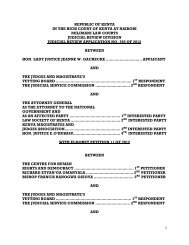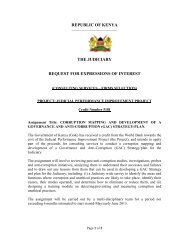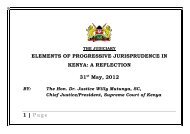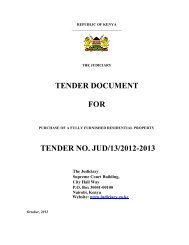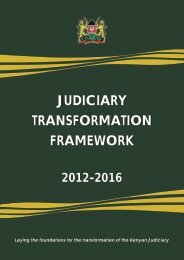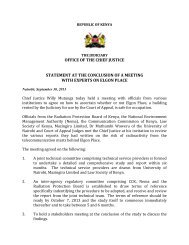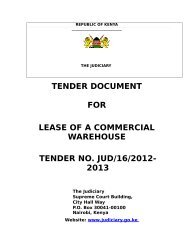Download PDF - The Judiciary
Download PDF - The Judiciary
Download PDF - The Judiciary
You also want an ePaper? Increase the reach of your titles
YUMPU automatically turns print PDFs into web optimized ePapers that Google loves.
Chapter 5<br />
State of <strong>Judiciary</strong> 2011-2012<br />
45<br />
5.0 GOVERNANCE AND MANAGEMENT REVIEW<br />
5.1 Overall Context Leading into 2011/12<br />
Chapter 10 of the Constitution, 2010, radically transformed<br />
the policy, legal and institutional context for the <strong>Judiciary</strong>,<br />
by emphasising, from a governance and management<br />
perspective, the critical values of integrity, efficiency, transparency,<br />
accountability and effectiveness in service (and in the case of the<br />
<strong>Judiciary</strong>, justice) delivery. <strong>The</strong> Constitution further created and<br />
fortified the independence of the <strong>Judiciary</strong>, including through<br />
the establishment of the <strong>Judiciary</strong> Fund – which has now been<br />
operationalised – and the dispersal of power.<br />
<strong>The</strong> period under review began as the launch pad for many<br />
initiatives to actualise the constitutional architecture of the<br />
<strong>Judiciary</strong> envisaged in numerous proposals and reports to improve<br />
its performance.<br />
Since its establishment as a law and order institution during the<br />
colonial era, the <strong>Judiciary</strong> has only operated – on paper - as an<br />
independent arm of Government for less than 20 years. It had been<br />
de-linked from the civil service as recently as 1993 at the beginning<br />
of the multi-parties political era. Since then, several studies have<br />
been conducted and recommendations made, by internal<br />
committees, on ways in which the <strong>Judiciary</strong> can be transformed<br />
to meet the ever changing needs and expectations of Kenyans.<br />
Each time these studies proposed clear and practical<br />
recommendations for performance improvement. Some<br />
implementation success was achieved at the institutional level,<br />
including the creation of specialised courts (and court divisions)<br />
and the establishment of the National Council for Law Reporting<br />
and <strong>Judiciary</strong> Training Institute. However, these isolated reforms<br />
were insufficient to bring the change needed to transform the<br />
<strong>Judiciary</strong> into a strong and independent institution that is properly<br />
governed and managed.<br />
<strong>The</strong> Judicial Service Commission, which was responsible for policy<br />
and oversight, was and its composition excluded important voices





